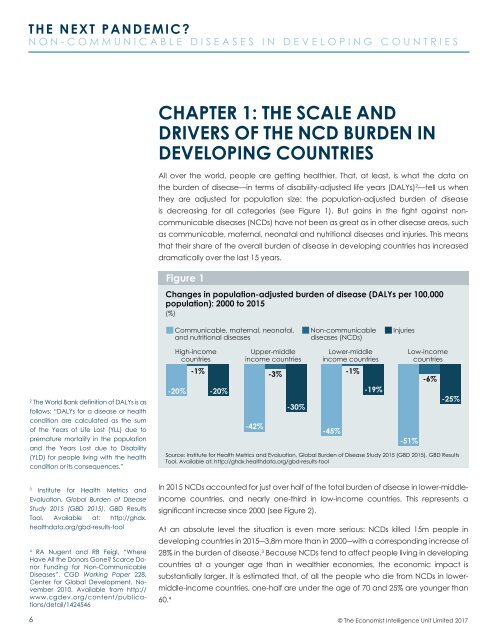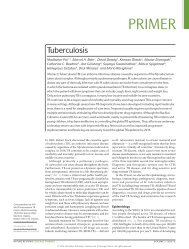THE NEXT PANDEMIC?
The_next_pandemic
The_next_pandemic
Create successful ePaper yourself
Turn your PDF publications into a flip-book with our unique Google optimized e-Paper software.
<strong>THE</strong> <strong>NEXT</strong> <strong>PANDEMIC</strong>?<br />
NON-COMMUNICABLE DISEASES IN DEVELOPING COUNTRIES<br />
CHAPTER 1: <strong>THE</strong> SCALE AND<br />
DRIVERS OF <strong>THE</strong> NCD BURDEN IN<br />
DEVELOPING COUNTRIES<br />
All over the world, people are getting healthier. That, at least, is what the data on<br />
the burden of disease—in terms of disability-adjusted life years (DALYs) 2 —tell us when<br />
they are adjusted for population size: the population-adjusted burden of disease<br />
is decreasing for all categories (see Figure 1). But gains in the fight against noncommunicable<br />
diseases (NCDs) have not been as great as in other disease areas, such<br />
as communicable, maternal, neonatal and nutritional diseases and injuries. This means<br />
that their share of the overall burden of disease in developing countries has increased<br />
dramatically over the last 15 years.<br />
Figure 1<br />
Changes in population-adjusted burden of disease (DALYs per 100,000<br />
population): 2000 to 2015<br />
(%)<br />
Communicable, maternal, neonatal,<br />
and nutritional diseases<br />
Non-communicable<br />
diseases (NCDs)<br />
Injuries<br />
2<br />
The World Bank definition of DALYs is as<br />
follows: “DALYs for a disease or health<br />
condition are calculated as the sum<br />
of the Years of Life Lost (YLL) due to<br />
premature mortality in the population<br />
and the Years Lost due to Disability<br />
(YLD) for people living with the health<br />
condition or its consequences.”<br />
High-income<br />
countries<br />
-1%<br />
-20%<br />
-20%<br />
Upper-middle<br />
income countries<br />
-42%<br />
-3%<br />
-30%<br />
Lower-middle<br />
income countries<br />
-1%<br />
-45%<br />
-19%<br />
Low-income<br />
countries<br />
-51%<br />
Source: Institute for Health Metrics and Evaluation, Global Burden of Disease Study 2015 (GBD 2015), GBD Results<br />
Tool. Available at: http://ghdx.healthdata.org/gbd-results-tool<br />
-6%<br />
-25%<br />
3<br />
Institute for Health Metrics and<br />
Evaluation, Global Burden of Disease<br />
Study 2015 (GBD 2015), GBD Results<br />
Tool. Available at: http://ghdx.<br />
healthdata.org/gbd-results-tool<br />
4<br />
RA Nugent and RB Feigl, “Where<br />
Have All the Donors Gone? Scarce Donor<br />
Funding for Non-Communicable<br />
Diseases”, CGD Working Paper 228,<br />
Center for Global Development, November<br />
2010. Available from http://<br />
www.cgdev.org/content/publications/detail/1424546<br />
6<br />
In 2015 NCDs accounted for just over half of the total burden of disease in lower-middleincome<br />
countries, and nearly one-third in low-income countries. This represents a<br />
significant increase since 2000 (see Figure 2).<br />
At an absolute level the situation is even more serious: NCDs killed 15m people in<br />
developing countries in 2015―3.8m more than in 2000―with a corresponding increase of<br />
28% in the burden of disease. 3 Because NCDs tend to affect people living in developing<br />
countries at a younger age than in wealthier economies, the economic impact is<br />
substantially larger. It is estimated that, of all the people who die from NCDs in lowermiddle-income<br />
countries, one-half are under the age of 70 and 25% are younger than<br />
60. 4<br />
© The Economist Intelligence Unit Limited 2017




